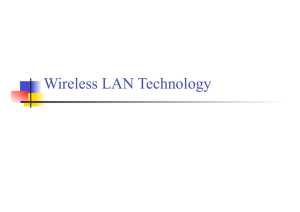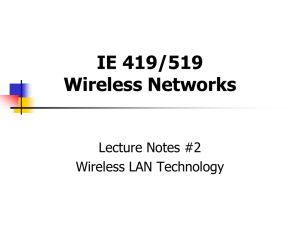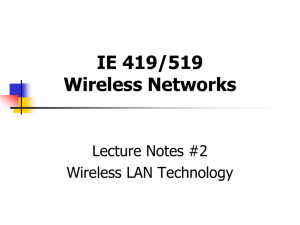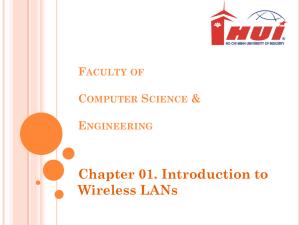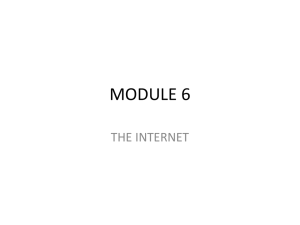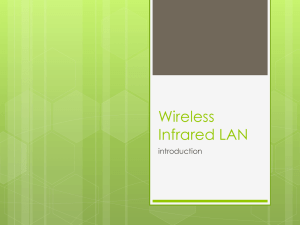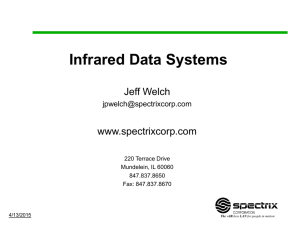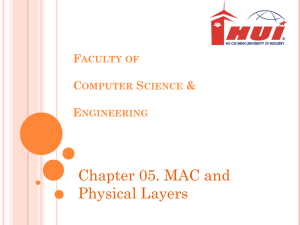WLAN - 長庚大學資訊工程學系
advertisement
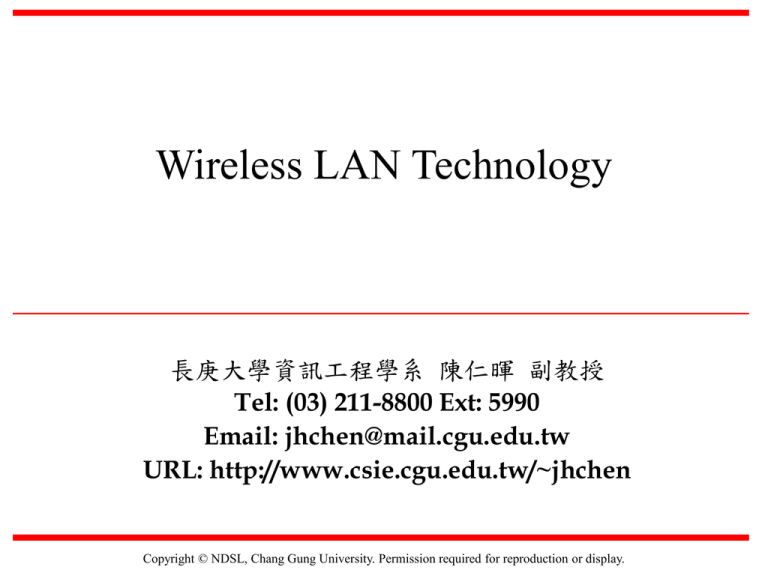
Wireless LAN Technology 長庚大學資訊工程學系 陳仁暉 副教授 Tel: (03) 211-8800 Ext: 5990 Email: jhchen@mail.cgu.edu.tw URL: http://www.csie.cgu.edu.tw/~jhchen Copyright © NDSL, Chang Gung University. Permission required for reproduction or display. Wireless LAN Applications • • • • 2 LAN Extension Cross-building interconnect Nomadic Access Ad hoc networking NDSLab Copyright@2008 LAN Extension • Wireless LAN linked into a wired LAN on same premises – Wired LAN • Backbone • Support servers and stationary workstations – Wireless LAN • Stations in large open areas • Manufacturing plants, stock exchange trading floors, and warehouses 3 NDSLab Copyright@2008 Example Single-Cell Wireless LAN Conf. 4 NDSLab Copyright@2008 Example Multi-Cell Wireless LAN Conf. 5 NDSLab Copyright@2008 Cross-Building Interconnect • Connect LANs in nearby buildings – Wired or wireless LANs • Point-to-point wireless link is used • Devices connected are typically bridges or routers 6 NDSLab Copyright@2008 Wireless Configuration 7 NDSLab Copyright@2008 Nomadic Access • Wireless link between LAN hub and mobile data terminal equipped with antenna – Laptop computer or notepad computer • Uses: – Transfer data from portable computer to office server – Extended environment such as campus 8 NDSLab Copyright@2008 Ad Hoc Networking • Temporary peer-to-peer network set up to meet immediate need • Example: – Group of employees with laptops convene for a meeting; employees link computers in a temporary network for duration of meeting 9 NDSLab Copyright@2008 802.11 Configurations - Independent • Independent – – – – one Basic Service Set (BSS) Ad Hoc network direct communication limited coverage area Station AH2 • Current research topics – – – – – Multi-Hop Routing (IETF MANET) Multicasting Multi-channel Access Security QoS ... Ad Hoc Network Station AH3 Station AH1 Mobile Station : STA 10 NDSLab Copyright@2008 Wireless LAN Requirements • • • • • • • • • • 11 Throughput Number of nodes Connection to backbone LAN Service area Battery power consumption Transmission robustness and security Collocated network operation License-free operation Handoff/roaming Dynamic configuration NDSLab Copyright@2008 Wired, Wireless, and Mobile Compare 12 NDSLab Copyright@2008 Wireless LAN Categories • Infrared (IR) LANs • Spread spectrum LANs • Narrowband microwave 13 NDSLab Copyright@2008 Strengths of Infrared over Microwave Radio • Spectrum for infrared virtually unlimited – Possibility of high data rates • Infrared spectrum unregulated • Equipment inexpensive and simple • Reflected by light-colored objects – Ceiling reflection for entire room coverage • Doesn’t penetrate walls – More easily secured against eavesdropping – Less interference between different rooms 14 NDSLab Copyright@2008 Drawbacks of Infrared Medium • Indoor environments experience infrared background radiation – Sunlight and indoor lighting – Ambient radiation appears as noise in an infrared receiver – Transmitters of higher power required • Limited by concerns of eye safety and excessive power consumption – Limits range 15 NDSLab Copyright@2008 IR Data Transmission Techniques • Directed Beam Infrared • Ominidirectional • Diffused 16 NDSLab Copyright@2008 Directed Beam Infrared • Used to create point-to-point links • Range depends on emitted power and degree of focusing • Focused IR data link can have range of kilometers – Cross-building interconnect between bridges or routers 17 NDSLab Copyright@2008 Token Ring LAN using P-to-P IR 18 NDSLab Copyright@2008 Ominidirectional • Single base station within line of sight of all other stations on LAN • Station typically mounted on ceiling • Base station acts as a multiport repeater – Ceiling transmitter broadcasts signal received by IR transceivers – IR transceivers transmit with directional beam aimed at ceiling base unit 19 NDSLab Copyright@2008 Diffused • All IR transmitters focused and aimed at a point on diffusely reflecting ceiling • IR radiation strikes ceiling – Reradiated omnidirectionally – Picked up by all receivers 20 NDSLab Copyright@2008 Spread Spectrum LAN Configuration • Multiple-cell arrangement (Figure 13.2) • Within a cell, either peer-to-peer or hub • Peer-to-peer topology – No hub – Access controlled with MAC algorithm • CSMA (Carrier Sense Multiple Access) – Appropriate for ad hoc LANs 21 NDSLab Copyright@2008 Typical Wireless IR LAN Configuration 22 NDSLab Copyright@2008 Spread Spectrum LAN Configuration • Hub topology – – – – – Mounted on the ceiling and connected to backbone May control access May act as multiport repeater Automatic handoff of mobile stations Stations in cell either: • Transmit to / receive from hub only • Broadcast using omnidirectional antenna 23 NDSLab Copyright@2008 Narrowband Microwave LANs • Use of a microwave radio frequency band for signal transmission • Relatively narrow bandwidth • Licensed • Unlicensed 24 NDSLab Copyright@2008 Licensed Narrowband RF • Licensed within specific geographic areas to avoid potential interference • Motorola - 600 licenses in 18-GHz range – Covers all metropolitan areas – Can assure that independent LANs in nearby locations don’t interfere – Encrypted transmissions prevent eavesdropping 25 NDSLab Copyright@2008 Unlicensed Narrowband RF • RadioLAN introduced narrowband wireless LAN in 1995 – – – – 26 Uses unlicensed ISM spectrum Used at low power (0.5 watts or less) Operates at 10 Mbps in the 5.8-GHz band Range = 50 m to 100 m NDSLab Copyright@2008
